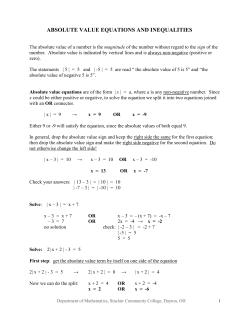
Section 1.7 Interval Notation and Linear Inequalities Rules for Solving Inequalities:
CHAPTER 1 Introductory Information and Review Section 1.7: Interval Notation and Linear Inequalities Linear Inequalities Linear Inequalities Rules for Solving Inequalities: 86 University of Houston Department of Mathematics SECTION 1.7 Interval Notation and Linear Inequalities Interval Notation: Example: Solution: MATH 1300 Fundamentals of Mathematics 87 CHAPTER 1 Introductory Information and Review Example: Solution: Example: 88 University of Houston Department of Mathematics SECTION 1.7 Interval Notation and Linear Inequalities Solution: Additional Example 1: Solution: MATH 1300 Fundamentals of Mathematics 89 CHAPTER 1 Introductory Information and Review Additional Example 2: Solution: 90 University of Houston Department of Mathematics SECTION 1.7 Interval Notation and Linear Inequalities Additional Example 3: Solution: Additional Example 4: Solution: MATH 1300 Fundamentals of Mathematics 91 CHAPTER 1 Introductory Information and Review Additional Example 5: Solution: Additional Example 6: Solution: 92 University of Houston Department of Mathematics SECTION 1.7 Interval Notation and Linear Inequalities Additional Example 7: Solution: MATH 1300 Fundamentals of Mathematics 93 Exercise Set 1.7: Interval Notation and Linear Inequalities For each of the following inequalities: (a) Write the inequality algebraically. (b) Graph the inequality on the real number line. (c) Write the inequality in interval notation. Write each of the following inequalities in interval notation. 23. 1. x is greater than 5. 2. x is less than 4. 3. x is less than or equal to 3. 4. x is greater than or equal to 7. 5. x is not equal to 2. 6. x is not equal to 5 . 7. x is less than 1. 8. x is greater than 6 . 9. x is greater than or equal to 4 . 24. 25. 26. 27. 10. x is less than or equal to 2 . 28. 11. x is not equal to 8 . 12. x is not equal to 3. 13. x is not equal to 2 and x is not equal to 7. Given the set S 2, 4, 3, 13 , use substitution to 14. x is not equal to 4 and x is not equal to 0. determine which of the elements of S satisfy each of the following inequalities. 29. 2 x 5 10 Write each of the following inequalities in interval notation. 15. x 3 16. x 5 17. x 2 18. x 7 30. 4 x 2 14 31. 2 x 1 7 32. 3x 1 0 33. x 2 1 10 34. 1 2 x 5 19. 3 x 5 20. 7 x 2 21. x 7 22. x 9 For each of the following inequalities: (a) Solve the inequality. (b) Graph the solution on the real number line. (c) Write the solution in interval notation. 35. 2 x 10 36. 3x 24 94 University of Houston Department of Mathematics Exercise Set 1.7: Interval Notation and Linear Inequalities 37. 5 x 30 38. 4 x 40 39. 2 x 5 11 40. 3x 4 17 41. 8 3x 20 42. 10 x 0 43. 4 x 11 7 x 4 44. 5 9 x 3x 7 45. 10 x 7 2 x 6 46. 8 4 x 6 5 x 60. (a) 3 x 5 (b) 8 x 1 (c) 2 x 8 (d) 7 x 10 Answer the following. 61. You go on a business trip and rent a car for $75 per week plus 23 cents per mile. Your employer will pay a maximum of $100 per week for the rental. (Assume that the car rental company rounds to the nearest mile when computing the mileage cost.) (a) Write an inequality that models this situation. (b) What is the maximum number of miles that you can drive and still be reimbursed in full? 47. 5 8 x 4 x 1 48. x 10 8 x 9 49. 3(4 5 x) 2(7 x) 50. 4(3 2 x) ( x 20) 51. 5 6 13 x 12 ( x 5) 52. 2 5 x 12 13 10 x 53. 10 3x 2 8 54. 9 2 x 3 13 55. 4 3 7 x 17 62. Joseph rents a catering hall to put on a dinner theatre. He pays $225 to rent the space, and pays an additional $7 per plate for each dinner served. He then sells tickets for $15 each. (a) Joseph wants to make a profit. Write an inequality that models this situation. (b) How many tickets must he sell to make a profit? 63. A phone company has two long distance plans as follows: Plan 1: $4.95/month plus 5 cents/minute Plan 2: $2.75/month plus 7 cents/minute How many minutes would you need to talk each month in order for Plan 1 to be more costeffective than Plan 2? 56. 19 5 4 x 3 57. 2 3 3 x1510 54 58. 3 4 562 x 53 Which of the following inequalities can never be true? 59. (a) 5 x 9 (b) 9 x 5 64. Craig’s goal in math class is to obtain a “B” for the semester. His semester average is based on four equally weighted tests. So far, he has obtained scores of 84, 89, and 90. What range of scores could he receive on the fourth exam and still obtain a “B” for the semester? (Note: The minimum cutoff for a “B” is 80 percent, and an average of 90 or above will be considered an “A”.) (c) 3 x 7 (d) 5 x 3 MATH 1300 Fundamentals of Mathematics 95
© Copyright 2025





















